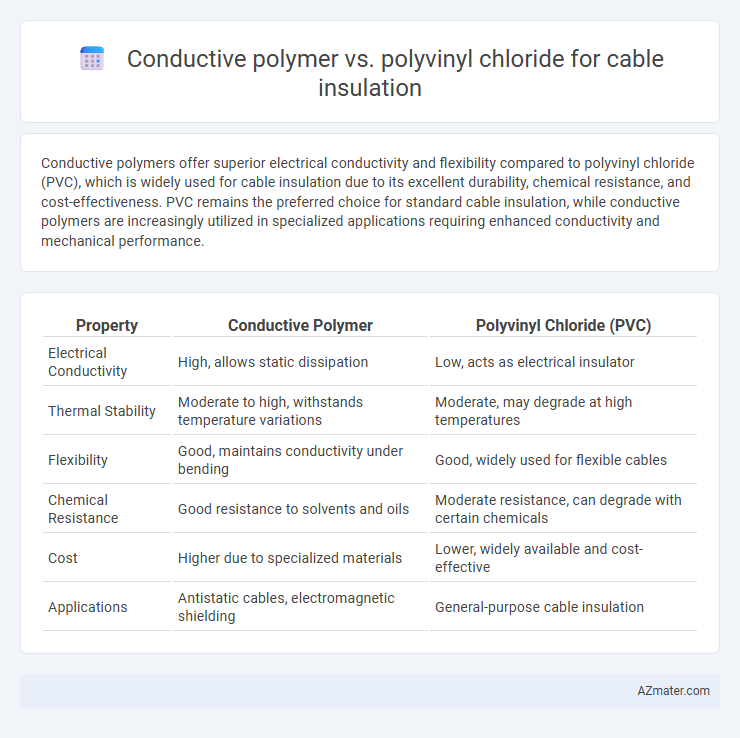Conductive polymers offer superior electrical conductivity and flexibility compared to polyvinyl chloride (PVC), which is widely used for cable insulation due to its excellent durability, chemical resistance, and cost-effectiveness. PVC remains the preferred choice for standard cable insulation, while conductive polymers are increasingly utilized in specialized applications requiring enhanced conductivity and mechanical performance.
Table of Comparison
| Property | Conductive Polymer | Polyvinyl Chloride (PVC) |
|---|---|---|
| Electrical Conductivity | High, allows static dissipation | Low, acts as electrical insulator |
| Thermal Stability | Moderate to high, withstands temperature variations | Moderate, may degrade at high temperatures |
| Flexibility | Good, maintains conductivity under bending | Good, widely used for flexible cables |
| Chemical Resistance | Good resistance to solvents and oils | Moderate resistance, can degrade with certain chemicals |
| Cost | Higher due to specialized materials | Lower, widely available and cost-effective |
| Applications | Antistatic cables, electromagnetic shielding | General-purpose cable insulation |
Introduction to Cable Insulation Materials
Conductive polymers and polyvinyl chloride (PVC) serve distinct roles in cable insulation materials, with PVC being a widely used thermoplastic known for its excellent electrical insulation, flexibility, and flame retardance. Conductive polymers offer unique properties such as intrinsic electrical conductivity and environmental stability, which can be tailored for advanced cable applications requiring anti-static or electromagnetic interference shielding. The selection between these materials depends on factors like electrical performance, mechanical durability, thermal stability, and specific application requirements for cable insulation systems.
Overview of Conductive Polymers
Conductive polymers, such as polyaniline and polypyrrole, offer enhanced electrical conductivity compared to traditional insulating materials like polyvinyl chloride (PVC), making them suitable for specialized cable insulation applications requiring electromagnetic interference shielding. These polymers provide flexibility, lightweight properties, and environmental resistance, addressing limitations of PVC such as rigidity and plasticizer leaching. Advances in conductive polymer composites improve thermal stability and mechanical strength, positioning them as innovative alternatives in next-generation cable insulation technology.
Properties of Polyvinyl Chloride (PVC)
Polyvinyl chloride (PVC) offers excellent chemical resistance, flame retardancy, and abrasion resistance, making it a popular choice for cable insulation in various industrial applications. Its high dielectric strength and good flexibility at room temperature enable reliable electrical performance and ease of installation. PVC's affordability and widespread availability further contribute to its extensive use in power, telecommunications, and household wiring cables.
Electrical Conductivity Comparison
Conductive polymers exhibit significantly higher electrical conductivity compared to polyvinyl chloride (PVC), which is inherently an electrical insulator used primarily for its dielectric properties. Conductive polymers such as polyaniline and polypyrrole facilitate electron flow, enabling applications that require antistatic or electromagnetic interference shielding characteristics in cable insulation. In contrast, PVC's low electrical conductivity ensures effective insulation and safety by preventing current leakage, making it suitable for standard electrical cable coatings.
Thermal Stability and Heat Resistance
Conductive polymers exhibit superior thermal stability and heat resistance compared to polyvinyl chloride (PVC) in cable insulation applications, maintaining structural integrity at temperatures exceeding 150degC, whereas PVC typically withstands up to 105degC before degradation. The inherent conjugated molecular structure of conductive polymers enhances their ability to dissipate heat and resist thermal aging, making them ideal for high-temperature environments. In contrast, PVC's plasticizers and additives can volatilize under heat, leading to embrittlement and reduced insulation performance over time.
Mechanical Strength and Flexibility
Conductive polymers offer superior flexibility compared to polyvinyl chloride (PVC), making them ideal for applications requiring frequent bending and movement. PVC, known for its high mechanical strength and durability, provides excellent resistance to physical stress and abrasion in cable insulation. However, the inherent rigidity of PVC limits flexibility, whereas conductive polymers maintain mechanical integrity without compromising pliability.
Environmental Impact and Sustainability
Conductive polymers offer enhanced environmental benefits compared to Polyvinyl chloride (PVC) due to their potential for recyclability and lower toxicity during production and disposal processes. PVC insulation releases harmful dioxins and chlorine-based compounds when incinerated, posing long-term ecological risks and challenges for waste management. Sustainable cable designs increasingly favor conductive polymers for their reduced carbon footprint and compliance with stricter environmental regulations.
Durability and Lifespan in Cables
Conductive polymers for cable insulation exhibit superior durability due to their inherent resistance to environmental degradation, such as UV exposure and chemical corrosion, extending cable lifespan significantly compared to Polyvinyl chloride (PVC). PVC insulation, while cost-effective and widely used, tends to become brittle over time when exposed to heat and mechanical stress, reducing its service life and increasing maintenance requirements. Studies show that cables insulated with conductive polymers can last upwards of 25-30 years in harsh conditions, whereas PVC-insulated cables typically have a lifespan of 15-20 years under similar conditions.
Cost Considerations and Market Availability
Conductive polymers generally have higher material and processing costs compared to polyvinyl chloride (PVC), making PVC the more cost-effective choice for cable insulation in large-scale production. PVC dominates the global market due to its low cost, ease of processing, and wide availability, whereas conductive polymers are niche materials often limited to specialized applications requiring enhanced electrical properties. Market availability of conductive polymers remains restricted by higher prices and less established supply chains compared to the broad accessibility and affordability of PVC insulation materials.
Future Trends in Cable Insulation Technologies
Conductive polymers offer enhanced flexibility, lightweight properties, and excellent conductivity, positioning them as promising materials for next-generation cable insulation compared to traditional polyvinyl chloride (PVC), which remains favored for its durability and cost-effectiveness. Innovations in nanocomposite conductive polymers improve thermal stability and environmental resistance, targeting applications in electric vehicles and renewable energy systems where high performance and sustainability are critical. Ongoing research emphasizes eco-friendly, flame-retardant conductive polymers to address PVC's environmental concerns and regulatory challenges, reinforcing the shift toward more advanced, sustainable cable insulation technologies.

Infographic: Conductive polymer vs Polyvinyl chloride for Cable insulation
 azmater.com
azmater.com